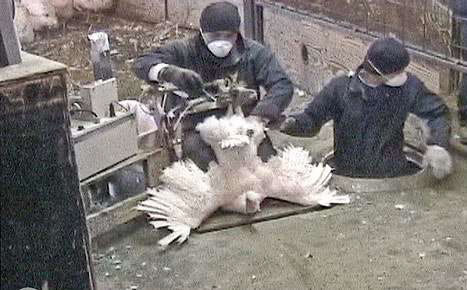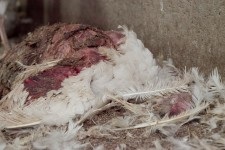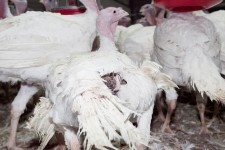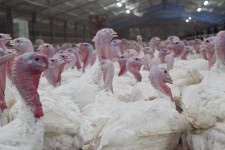- Overview
- Confinement
- Turkey poults
- Mutilation
- Artificial lighting
- Health Concerns
- Use of antibiotics
- Genetic alterations
- Muscle disorders
- Skeletal disorders
- Lame and injured birds
- Mortality rate
- Artificial insemination
- Health problems of breeders
- Slaughterhouse
- Turkeys: sentient and intelligent
- Conclusion
- References
Artificial Insemination
Turkeys' lives are manipulated at every point from conception to slaughter. There are two main commercial breeds of turkey in Australia, the Nicholas White and the Hybrid.(64) The genetic material (of these breeds) is imported from the US and Canada and the eggs are then hatched under strict quarantine conditions.(65)
The quarantine-born 'breeder turkeys' go on to produce more eggs.(66) Breeder turkeys are raised in the same conditions as turkeys intended specifically for meat. However, breeder turkeys are kept in breeding facilities for close to a year, so their welfare problems are magnified. Birds are selectively bred for production traits such as fast growth and extremely large bodies. Male breeder turkeys are so big they are unable to perform natural behaviours such as mating. Instead, artificial insemination is practised.(67)
The male tom turkeys are 'milked'. A worker pins the turkey down in a bent-over position. The worker then grabs the turkey's penis, stroking and masturbating it until the tom ejaculates.(68) The semen is collected, laced with extenders (a liquid to preserve fertilizing ability) and antibiotics, and then injected via syringe into the female turkey. The female turkeys are rushed along inside the hatchery and the treatment and handling deteriorate as the workers become tired and frustrated and lose concentration, causing the turkeys to suffer increased pain and trauma.(69)
The AI process is repeated once or twice a week until the breeder turkeys are slaughtered at one year of age.(70) (See Figure 13). The AI process is undoubtedly painful and causes injury and suffering to which the industry conveniently turns a blind eye. The majority of Australian States and Territories have laws that prohibit sexual contact with animals. However, farm animals are excluded from these laws because sexual contact is an integral part of artificial insemination procedures. As previously stated, this procedure causes injury and suffering and increases the birds' stress.
Interestingly, according to the Food and Agriculture Organisation of the United Nations, without artificial insemination performed by humans, the specific breed of turkey used in the AI process would become extinct in just one generation.(71) The possibility of this is of great concern because it reminds us of the sinister power of humanity, which continues to exacerbate the extinction rates of other species. The problem is not only loss of the species and the reliance on the unnaturalness of artificial insemination but the loss of the genetic diversity within species, as well as the loss of diversity of different types of ecosystems which can contribute to or hasten whole species extinction.(72)
Preserving the wider gene pool is important for the evolution of new species.(73) Scientists have postulated that commercial breeding for specific production traits threatens both animal welfare and genetic diversity.(74) An article in Science News states that 'Standard supermarket birds are a separate breed with a dwindling gene pool... Just 50 years ago, there were more than 200 breeds and varieties of poultry in agricultural use. Today there are less than a dozen 'improved types'.(75)

 Figure 13: Artificial Insemination in practice - quick capture and rough handling often causes injury and stress to turkeys. The same procedure takes place in Australia.
Figure 13: Artificial Insemination in practice - quick capture and rough handling often causes injury and stress to turkeys. The same procedure takes place in Australia.



